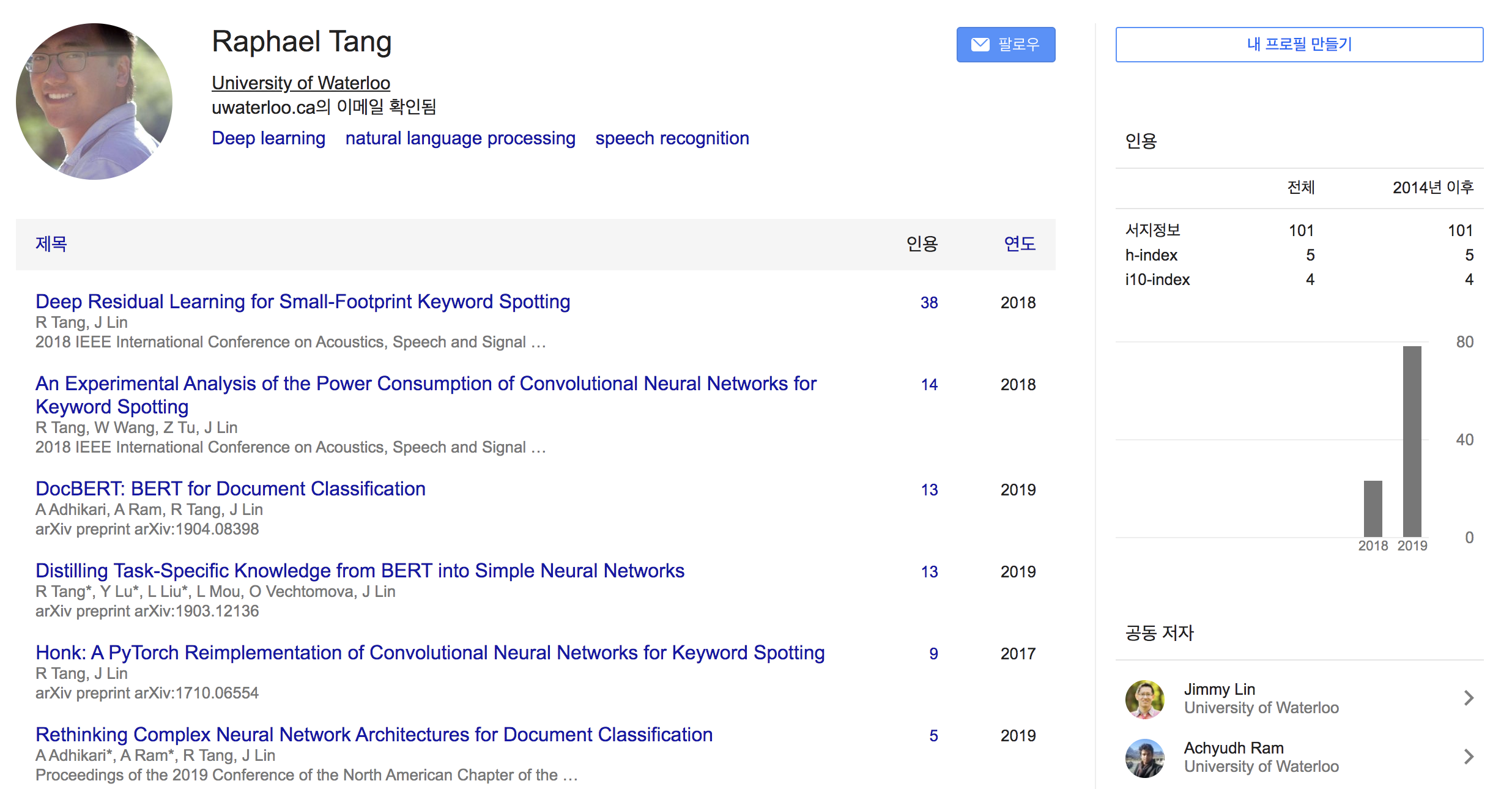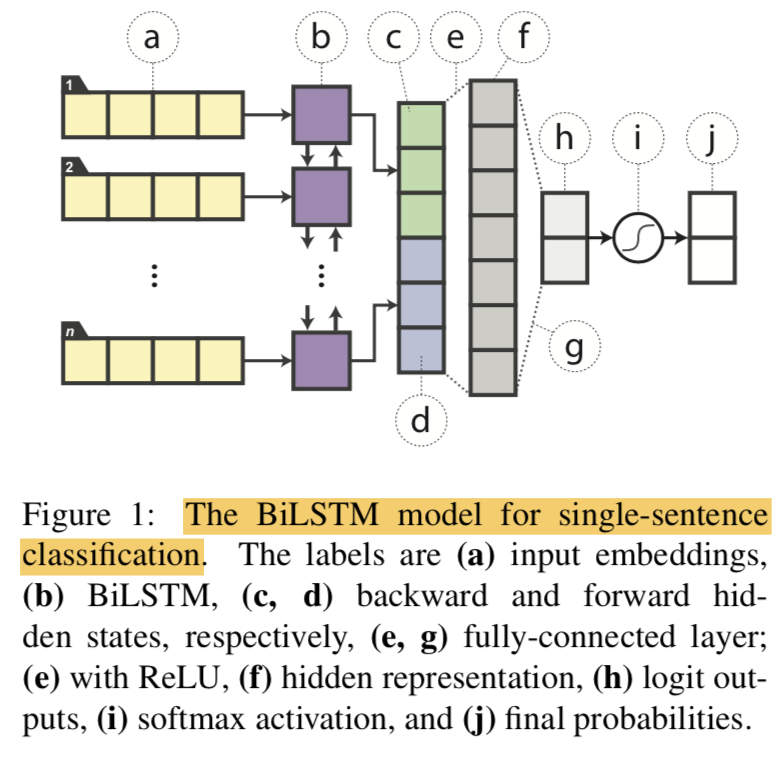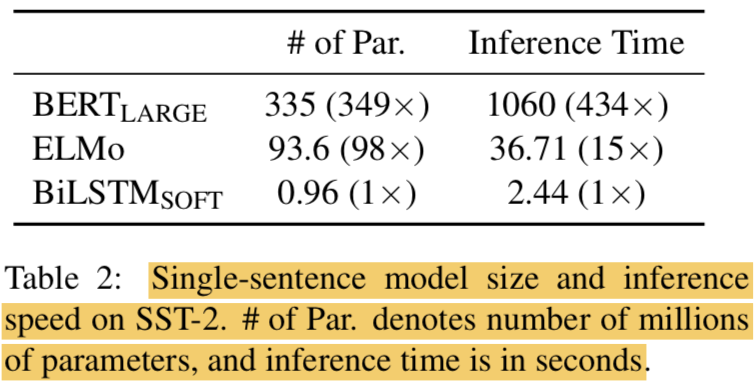Distilling Task-Specific Knowledge from BERT into Simple Neural Networks
Author
- 저자:
- Raphael Tang∗, Yao Lu∗, Linqing Liu∗, Lili Mou, Olga Vechtomova, and Jimmy Lin (University of Waterloo)
Who is an Author?
- ICASSP를 들고 있는 NLP 하던 분인 듯
- 보통은 문서분류쪽 많이 한듯
 {: height=”50%” width=”50%”}
{: height=”50%” width=”50%”}
느낀점
- 아이디어는 간단함
- Data Augmentation을 넣은건 좋았음
- 그러나 성능이 좋아진게 Distillation 때문인지 Data Augmentation 때문인지를 정확히 다루지 않아서.. 이 부분이 이 논문의 최대 에러임
Abstract
- 요즘엔 BERT, ELMo, and GPT 같은 deep language representation model이 대세임
- 이러한 발전은 예전에 쓰던 shallower neural networks 를 안쓰게 만듬
- 본 논문에서는 lightweight neural network도 구조 변경, 추가 데이터, 추가 feature 없이도 아직 쓸만하다는걸 보여주려고함
- BERT에서 Knowledge distillation 해서 성능을 높여보려고함
- setence classification, sentence-pair task 등으로 테스트 할 것임
- ELMo보다 100배 적은 파리미터, 15배 빠른 추론속도로 비슷한 성능을 얻음
1. Introduction
- BERT등이 등장하면서 “first-generation” neural network가 잘 안쓰이게됨
- 본 논문에서는 간단하지만 효과적인 transfer 기법을 제안하고자함 (task-specific knowledge from BERT)
- single-layer BiLSTM을 사용할거고, BERT로부터 배울 것임
- 효율적인 knowledge transfer 를 위해선 데이터가 많이 필요하니, unlabled dataset으로부터 teacher output을 만들어서 student로 학습하게 할 것임
2. Related Work
- NLP에서 CNN, RNN 등이 발달됨
- 최근엔, ELMo(6가지 task SOTA 찍었음), BERT등이 등장함
- Model Compression:
- local error-based method for pruning unimportant weights (LeCun et al. (1990))
- Han et al. (2015) propose a simple compression pipeline, achieving 40 times reduction in model size without hurting accuracy. Unfortunately, these techniques induce irregular weight sparsity, which precludes highly optimized computation routines
- quantizing neural networks (Wu et al., 2018); in the extreme, Courbariaux et al. (2016) propose binarized networks with both binary weights and binary activations
- 위에서 소개된 Model Compression과는 다르게 본 논문에서는 knowledge distillation appoach (Ba and Caruana, 2014; Hinton et al., 2015) 를 사용하고자함
- NLP에서 이미 이것에 대해 적용된 연구들이 있음(In the NLP literature, it has previously been used in neural machine translation (Kim and Rush, 2016) and language model- ing (Yu et al., 2018))
3. Our Approach
- First, teacher model과 student model을 선택 후 학습
- Second, 저자의 distillation procedure로 학습
- logits-regression objective 사용
- transfer dataset 구축
3.1 Model Architecture
Teacher network : pretrained, fine-tuned BERT
- feature vector ${ \boldsymbol{h} \in \mathbb{R}^{d} }$ 위에 우리가 사용할 classifier를 task에 맞게 추가해서 쓸것임
- For single-sentence classification
- 다음과 같이 softmax 추가해서 쓸 것임(${k}$ is the number of label) ${ \boldsymbol{y}^{(B)}=\operatorname{softmax}(W \boldsymbol{h}), \text { where } W \in \mathbb{R}^{k \times d} }$
- For sentence-pair task
- 두 문장에 대한 BERT features를 concat후 softmax layer에 넣는 방식으로 함
- 학습시에는 BERT와 classifier에 대한 param을 둘다 업데이트하고 cross-entropy loss 사용함
Student model: single-layer BiLSTM with a non-linear classifier
For classification
- last step의 값을 concat 후 fc layer with ReLU 에 feed해서 softmax layer로 분류함
 {: height=”50%” width=”50%”}
{: height=”50%” width=”50%”}
- last step의 값을 concat 후 fc layer with ReLU 에 feed해서 softmax layer로 분류함
For Sentence-pair tasks
- BiLSTM encoder weights를 share해서 siamese architecture로 사용 ${ \text { sentence vectors } \boldsymbol{h}{s 1} \text { and } \boldsymbol{h}{s 2} }$ 를 만들어냄
- ${ \begin{array}{l}{f\left(\boldsymbol{h}{s 1}, \boldsymbol{h}{s 2}\right)=\left[\boldsymbol{h}{s 1}, \boldsymbol{h}{s 2}, \boldsymbol{h}{s 1} \odot\right.} {\left.\boldsymbol{h}{s 2},\left|\boldsymbol{h}{s 1}-\boldsymbol{h}{s 2}\right|\right], \text { where } \odot \text { denotes elementwise multiplication}}\end{array} }$
 {: height=”50%” width=”50%”}
{: height=”50%” width=”50%”} - attenion이나, layer norm 같은 스킬은 최대한 제외하고 BiLSTM의 representation Power에만 국한하는 설계를 함
3.2 Distillation Objective
- In addition to a one-hot predicted label, the teacher’s predicted probability is also important. In binary sentiment classifica- tion, for example, some sentences have a strong sentiment polarity, whereas others appear neutral.
- If we use only the teacher’s predicted one-hot label to train the student, we may lose valuable information about the prediction uncertainty.
$$
\widetilde{y}{i}=\operatorname{softmax}(\boldsymbol{z})=\frac{\exp \left{\boldsymbol{w}{i}^{\top} \boldsymbol{h}\right}}{\sum_{j} \exp \left{\boldsymbol{w}_{j}^{\top} \boldsymbol{h}\right}}
$$
$$
\begin{array}{l}{\text { where } w_{i} \text { denotes the } i^{\mathrm{th}} \text { row of softmax weight }} \ {W, \text { and } z \text { is equivalent to } \boldsymbol{w}^{\top} \boldsymbol{h} .}\end{array}
$$
Training on logits makes learning easier for the student model since the relationship learned by the teacher model across all of the targets are equally emphasized (Ba and Caruana, 2014).
student network’s logits과 teacher’s logits의 MSE로 distillation objective를 만듬 (Cross entropy등도 사용하능하나, 저자의 실험에서 MSE가 좀 더 결과가 좋았다고함)
$$
\mathcal{L}{\text {distill }}=\left|z^{(B)}-z^{(S)}\right|{2}^{2}
$$최종적인 Loss는 기존의 one-hot에 대한 CE loss와 distill Loss를 weighted sum해서 사용함 (${t}$는 one-hot label)
$$
\begin{array}{l}{\mathcal{L}=\alpha \cdot \mathcal{L}{\mathrm{CE}}+(1-\alpha) \cdot \mathcal{L}{\text {distill }}} \ {=-\alpha \sum_{i} t_{i} \log y_{i}^{(S)}-(1-\alpha)\left|z^{(B)}-z^{(S)}\right|_{2}^{2}}\end{array}
$$- unlabeld data의 경우엔 teacher가 예측한걸 기준으로 사용함 ${ \begin{array}{l}{\text { i.e., } t_{i}=1 \text { if } i=\arg \max y^{(B)} \text { and } 0 \text { otherwise. }}\end{array} }$
3.3 Data Augmentation for Distillation
- 데이터 셋 작으면 티쳐한테 배울때 효과가 별로 없음
- 그렇기 때문에 데이터셋 키우기로함 (with pseudo-labels provided by the teacher)
- 하지만.. NLP에서의 Data augmentation은 Computer vision에 비해 어려움
- CV는 비슷한 이미지들이 매우 많음 (CIFAR-10 is a subset of the 80 million tiny images dataset)
- CV는 이미지 회전이나 노이즈 추가등.. 방법이 많음 (Second, it is possible to synthesize a near-natural image by rotating, adding noise, and other distortions)
- NLP에서 이 방법 쓰면 not be fluent되기 때문에 쓸 수 없음 ㅠ
- 본 논문에서는 약간의 휴리스틱으로 task-agnostic data augmentation을 하려고함 (image distortion과 같진 않고, 비슷하다고 생각하면됨)
- Masking:
- ${p_{mask}}$ 의 확률로 랜덤하게 단어를 [MASK]로 바꿈
- Intuitively, this rule helps to clarify the contribution of each word toward the label (각 단어의 contribution을 파악하는데 도움이 된다고 주장)
- e.g., the teacher network produces less confident logits for “I [MASK] the comedy” than for “I loved the comedy.”
- POS-guided word replacement:
- ${p_{pos}}$ 의 확률로 단어를 같은 pos 태그를 갖는 다른 단어로 교체함 (
허허 요상한 방법일세) - 이러한 룰은 semantic을 방해하기도 함 (This rule perturbs the semantics of each example, e.g., “What do pigs eat?” is different from “How do pigs eat?”)
- ${p_{pos}}$ 의 확률로 단어를 같은 pos 태그를 갖는 다른 단어로 교체함 (
- n-gram sampling:
- ${p_{ng}}$ 의 확률로 예시 문장에서 n-gram을 샘플링함 (n is randomly selected from {1,2,…,5})
- n-gram 외의 단어는 드랍해버리는것과 비슷한 효과고 마스킹보다 더 공격적인 방법임 (This rule is conceptually equivalent to dropping out all other words in the example, which is a more aggressive form of masking)
- Masking:
- Data augmentation procedure:
- training example ${w_{1}, …, w_{n}}$
- 단어에 대해서 iteration 하면서 각 단어에 대해서 유니폼 분포로 확률을 계산함 ${ X_{i} \sim \text { UNIFORM }[0,1] \text { for each } w_{i} }$
- ${ \text{if } X_{i}<p_{\text {mask }}, \text { we apply masking to } w_{i} }$
- ${ \text{if } p_{\text {mask}}<X_{i}<p_{\text {mask }} + p_{\text {pos }}, \text { we apply POS-guided word replace to } w_{i} }$
- masking과 POS-guided swapping은 mutuially exclusive하게 진행해서 한개가 적용되면 나머지는 적용안함
- iteration이 끝나면, ${p_{ng}}$의 확률로 n-gram sampling을 synthetic example(위에서 만든 문장)에 적용하면 final synthetic example이 완성됨
- 이러한 전체 프로세스를 한 문장당 $ n_{iter} $번 적용해서 총 $ n_{iter} $개의 문장을 만듬 (중복은 제거)
- For sentence-pair datasets, we cycle through augmenting
the first sentence only (holding the second fixed),the second sentence only (holding the first fixed), andboth sentences.
4. Experimental Setup
- Teacher Network으로써의 BERT는 large 버전 사용
- BERT fine-tuning 할 땐 Adam opt with lr {2,3,4,5} X ${10^{-5}}$ 적용
- val set 기준 best model 선택
- 여기선 data augmentation 안씀
- Student model 학습할 땐 data augmentation 사용
- soft logit target을 사용한 모델을 ${\text BiLSTM_{SOFT}}$ 로 표기하겠음
- 3.2 세션에서 weighted sum으로 기존 CE와 distillation Loss를 추가해서 만들었는데 ${\alpha = 0}$으로 셋팅해서 distillation objective만 사용한게 젤 잘나왔음
4.1 Datasets
- GLUE에서 3개 뽑아서 씀
- SST-2: movie reviews for binary sentiment classification (positive vs. negative)
- MNLI: to predict the relationship between a pair of sentences as one of entailment, neutrality, or contradiction
- QQP: binary label of each question pair indicates redundancy
4.2 Hyperparameters
- Student Model
- BiLSTM hidden: 150 or 300
- RelLU activated hidden: 200 or 400
- Optim: AdaDelta (lr: 1.0 ${\rho}$: 0.95)
- Batch size: 50 (SST2), 256 (MNLI, QQP)
- Data Augmentation
- ${p_{mask} = p_{pos} = 0.1 \text{ and } p_{ng} = 0.25}$
- ${n_{iter}} = 20$ (SST), ${n_{iter}} = 10$ (MNLI, QQP)
4.3 Baseline Models
- BERT
- OpenAI GPT
- GLUE ELMo baselines
5. Results and Discussion
5.1 Model Quality
 {: height=”50%” width=”50%”}
{: height=”50%” width=”50%”}
- our distillation approach of matching logits using the augmented training dataset, and achieve an absolute improvement of 1.9– 4.5 points against our base BiLSTM.
data augmentation 없이 distillation한 것도 보여줘야.. 설득력이 더 있을텐데 음..
5.2 Inference Efficiency
- On a single NVIDIA V100 GPU
- with a batch size of 512 on all 67350 sentences of the SST-2 training set
- our single-sentence model uses 98 and 349 times fewer parameters than ELMo and BERTLARGE, respectively
- 15 and 434 times faster
 {: height=”50%” width=”50%”}
{: height=”50%” width=”50%”}
6. Conclusion and Future Work
- Explore distilling the knowledge from BERT into a simple BiLSTM-based model
- The distilled model achieves comparable results with ELMo, while using much fewer parameters and less inference time
- Future work로는 더 단순한 모델로 KD하거나 더 복잡한 모델로 KD하거나..(
이거 넘 당연한 발상아닌가..)
Code
ref: https://github.com/qiangsiwei/bert_distill
Note:
- marp syntax 변경: https://marpit.marp.app/image-syntax
Distilling Task-Specific Knowledge from BERT into Simple Neural Networks